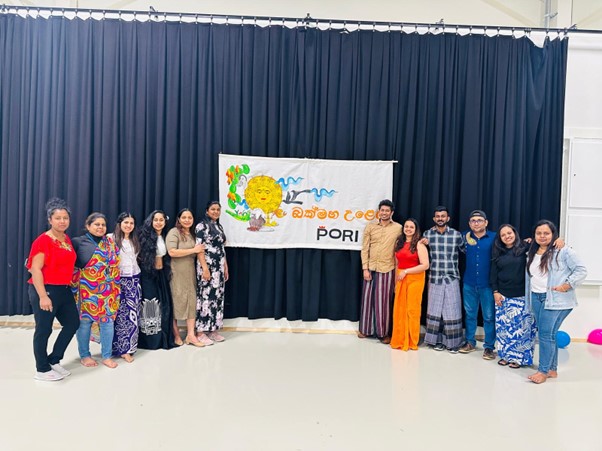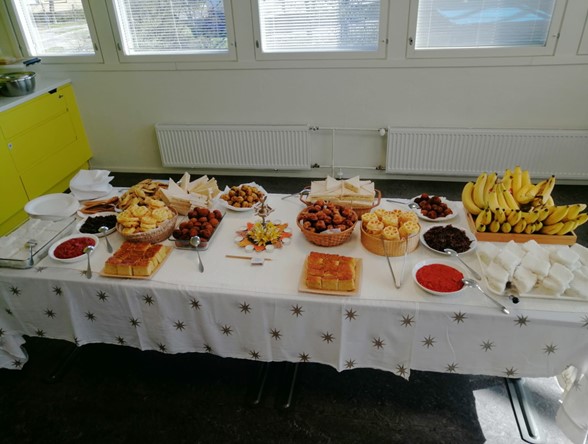On 16th of May 2024, the Sri Lankan tourism students at SAMK University of Applied Sciences marked a historic occasion by celebrating the Sinhala and Hindu New Year festival for the first time at the Agora Hall. This vibrant event brought the warmth and richness of Sri Lankan culture to the heart of the university, making it a memorable day for all attendees.


One of the highlights of the celebration was the incredible arrange of traditional Sri Lankan foods. The culinary spread included:
Kiribath (Milk Rice): A must-have for any New Year celebration, kiribath is made by cooking rice with coconut milk, giving it a rich and creamy texture. It was served with lunu miris, a spicy onion relish that added a delightful kick. This white milk rice always brings us the feeling of peace.
Kevum (Oil Cakes): These sweet, deep-fried delicacies made from rice flour and treacle were a hit among attendees. Their crunchy exterior and soft, sweet interior were irresistible.
Kokis is intricate, flower-shaped cookie made from rice flour and coconut milk – both a visual and gastronomic delight. I saw everyone taken two three times to their plates to take the experience of crunchy sound and the sweetness .
Naran kevum is rich and made from little pieces of coconut and flour with sugar. This was another traditional sweet item that was a crowd favorite.
Aside from these, many more sweet and chilly food items were available on the table to make different experiences for the international crowd of all who participated.

It was such a nice experience to all of the Sri Lankan students when the international crowd eating so chilly and so sweet taste with a variety of foods . These provided a savory balance to the sweet treats, showcasing the diverse flavors of Sri Lankan cuisine.
The event was graced by several lecturers from SAMK University who took the opportunity to express their appreciation for the Sri Lankan students’ initiative. They commended the students for their hard work in organizing such a vibrant and culturally enriching event.
To make the colourful this event we invited some of the staff members and the lecturers of the degree program of international Tourism management: Jukka Mäkinen, Jaana Ruoho, Emma Roinila, Jonna Huuhka, Liisa Suominen, Heini Korvenkangas, Teija Nuurma, Tiina Leino, Marja Tomberg, Jere Kuusinen, Jeffrey Salahub, Iira Ostamo and Timo Salomaa. They made a wonderful start with lightning the traditional oil lamp as a start of the new year before the event.
Head of Teaching, Mr Jukka Makinen remarked: ”This celebration not only brings us closer as a community but also enriches our understanding of the diverse cultures that our students represent. The Sri Lankan New Year festival has added a new dimension to our cultural landscape, and we are thrilled to be a part of it.”

In addition to the delicious food and cultural presentations, the event featured a variety of traditional New Year games that brought joy and laughter to everyone:
Kotta Pora (Pillow Fighting): This game involved contestants balancing on a horizontal bar while trying to knock each other off with pillows. The light-hearted competition and the inevitable tumbles were a source of great amusement.
Tug of War: Teams competed in a spirited tug of war, showcasing their strength and teamwork. The enthusiastic support from the crowd added to the energy of the game.
Other games played included Balloon dance , Running with lime on a spoon , Secret guest , Counting seeds of inside papaw, Music chair , Three legs running and many more.
The celebration of the Sinhala and Hindu New Year at SAMK University was more than just a festive gathering. It was a testament to the power of cultural exchange and the strong sense of community at the university. Students, staff, and faculty came together to enjoy, learn, and appreciate the rich traditions of Sri Lanka. In this occasion we felt that everyone forget their positions and had a great fun with lots of laughter together .
As the event came to a close, it was clear that this inaugural celebration had set a new standard for cultural events at SAMK. The joy, laughter, and unity experienced throughout the day will be cherished memories for all who attended, and it is hoped that this will become an annual tradition that continues to enrich the university community.
This historic celebration has paved the way for future cultural events at SAMK University, highlighting the importance of diversity and inclusion. We look forward to more such events that celebrate the unique cultures and traditions of our international student community.
Thank you to everyone who contributed to making this event a resounding success. Your enthusiasm and hard work have created lasting memories and have made a significant impact on the SAMK community.
Text and pictures: Nayani Wasana Kalubowilage, second year International Tourism Management student

